Maverick Crypto: Decline in LSD Market Share, Lack of Network Effects for stETH, Lido Valuation May Be Overestimated
Original Author: Asa Li, Maverick Crypto
Original Title: 《Counterpoint on Lido (LDO): Declining Momentum and Overshot Expectations》
Compiled by: Deep Tide TechFlow
Today, we will briefly introduce our observations on the adoption of stETH and Ethereum liquid staking, which we believe is not meeting expectations.
TLDR:
- The percentage of stETH and LSD in the total ETH staked is losing market share.
- stETH has not truly achieved the DeFi network effect and cannot significantly differentiate itself from smaller liquidity or non-liquid competitors that offer better rates.
- It is more difficult for stETH to surpass WETH in DeFi than many people imagine. Behavioral inertia, the focus on native tokens, declining community momentum, and Lido's slow governance model all pose resistance to Lido's adoption prospects.
- Given that the adoption of stETH is worse than expected, we believe investors should slightly discount Lido's consensus position (ETH price x EL activity fees) rather than apply a premium. This discount considers the risk of the decline in "stETH/total staked Ethereum" market share due to market fragmentation.
Observation: More People Choose Non-Liquid Staking Over Liquid Staking
From April 2023 to August 2023, Ethereum's staking ratio grew from 14.13% to 21.32%, an increase of 50% in just four months.
However, of the additional 8.6 million ETH staked, the vast majority (67%) was used for non-liquid staking. Lido's stETH accounted for less than 25% of the total increase in staked ETH. This means that Lido's market share of all staked ETH dropped from 35% in April to 31.5% in August.
Even considering the additional Ethereum issuance from the higher staking ratio and excluding volatile factors like execution layer rewards, Lido's total revenue actually declined between April and August, despite the circulating amount of stETH increasing from 5.8 million to 8 million.
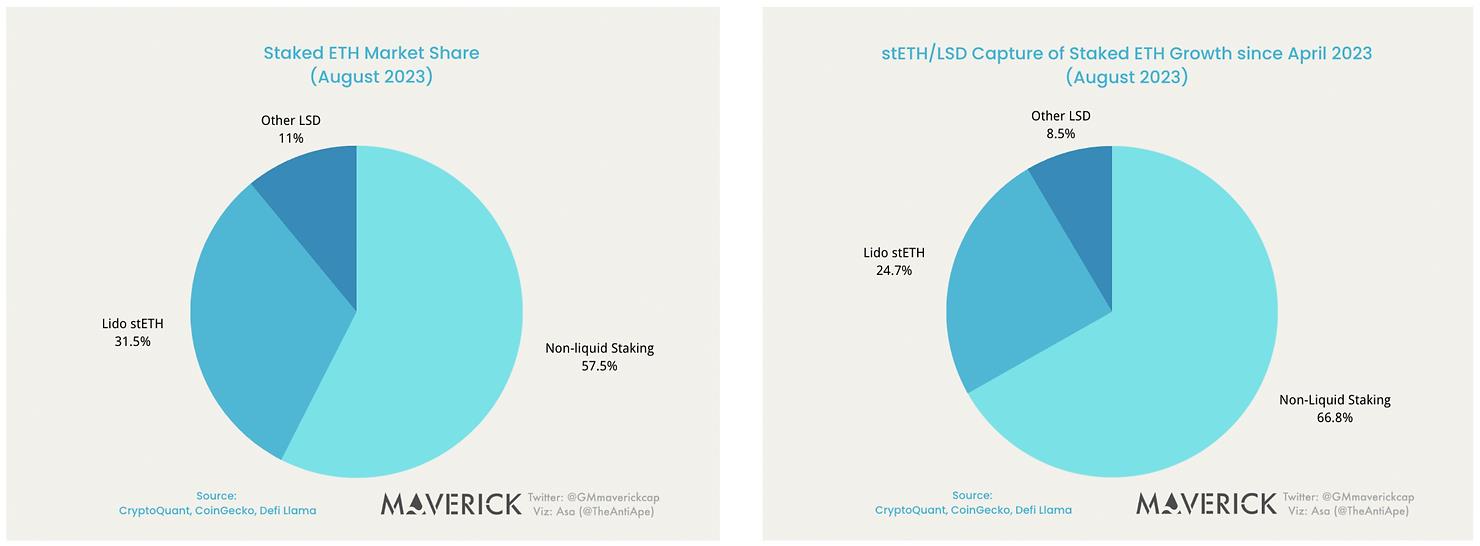
Why is this happening? We hypothesize the following reasons:
Price: Lido's 10% fee rate hurts the incentives for stakers. Other validator service providers in the market offer an annual yield of 4.4%, while Lido's stETH currently offers only 3.8%.
Lack of Network Effects: Lido's stETH/wstETH currently has only one real use case: collateralizing USDC/DAI on AAVE and Maker with wstETH. However, with a net borrowing rate of 4% - 5% and a maximum loan-to-value (LTV) ratio of 72%, merely relying on borrowing/leverage operations does not provide a strong impetus for stETH demand. Additionally, stETH lacks true DeFi composability or network effects.
Where is stETH Currently Used?
Let's take a look at stETH in the DeFi ecosystem.

- 55% of stETH tokens are passively held outside of DeFi contracts (store of value).
- 40% of stETH tokens are held in lending protocols like AAVE and Maker (lending/collateral).
- 3% is used for providing liquidity on Curve and Uniswap, facilitating exchanges between ETH and stETH (medium of exchange).
- Less than 1% of stETH is used in new "LSDFi" protocols like Pendle.
Lending Market/Collateral
Lending/collateral is stETH's most successful use case to date. stETH has surpassed ETH to become the number one collateral asset on all major lending platforms on ETH L1.
As shown below, stETH/wstETH is the most commonly used collateral asset on Maker and AAVE. On the other hand, there is almost no lending of wstETH/stETH from AAVE, resulting in a supply annual yield of 0%. This indicates a lack of other use cases beyond collateral.
One thing to note here is that as a use case, collateral does not require and will not bring much network effect to the token: AAVE can accept 10 different types of LSD. The existence of stETH does not affect the loan-to-value (LTV) ratio or interest rates of rETH. Even if stETH becomes the largest deposited asset, this fact alone does not provide anyone with more reasons to buy, hold, or lend stETH instead of rETH.
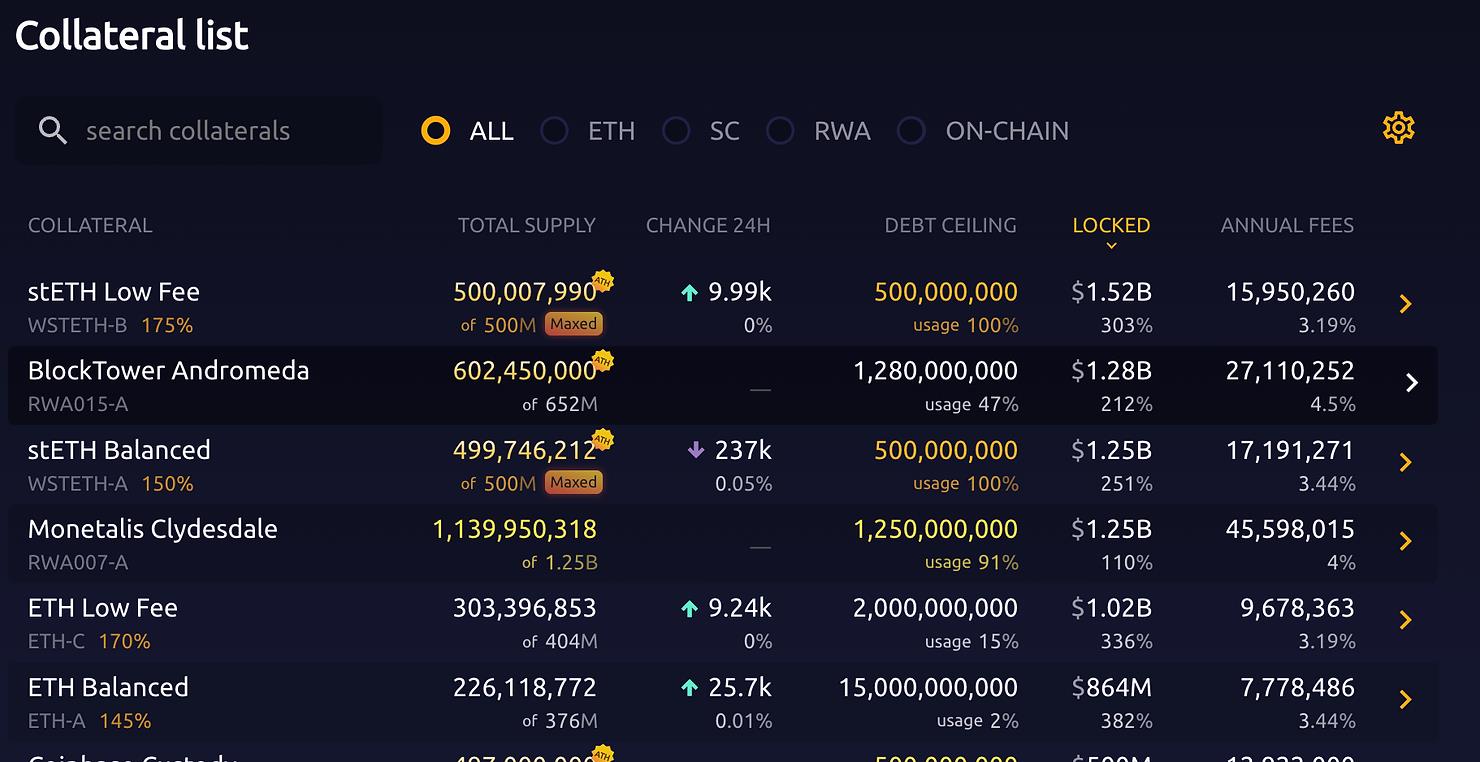

As a Medium of Exchange: No Progress on Uniswap
An important aspect of liquid staking is its compatibility with DeFi: one day, stETH will become what WETH is today. A crucial step in this process is to leverage stETH as a medium of exchange: if people believe stETH is the most convenient token that can be easily exchanged for any other token, they will hold stETH freely, and large holders will buy stETH to provide liquidity on exchanges like Uniswap.
However, on Uniswap V2 and V3, despite hundreds of new trading pairs being launched every month since April, almost all are based on WETH. The presence of stETH on Uniswap is very limited; it is seen as a commodity exchanged from WETH/USDC (the consensus medium of exchange) rather than as a medium of exchange itself.
It is also worth mentioning that centralized exchanges have even less interest in stETH than liquidity providers on decentralized exchanges. This tells us that there is indeed a higher cognitive barrier to adopting stETH compared to ETH. Newcomers who have heard about the wonders of Ethereum or checked CoinMarketCap are likely to continue happily trading and holding ETH. (Native ETH will soon be supported on Uniswap V4. Goodbye, WETH.)
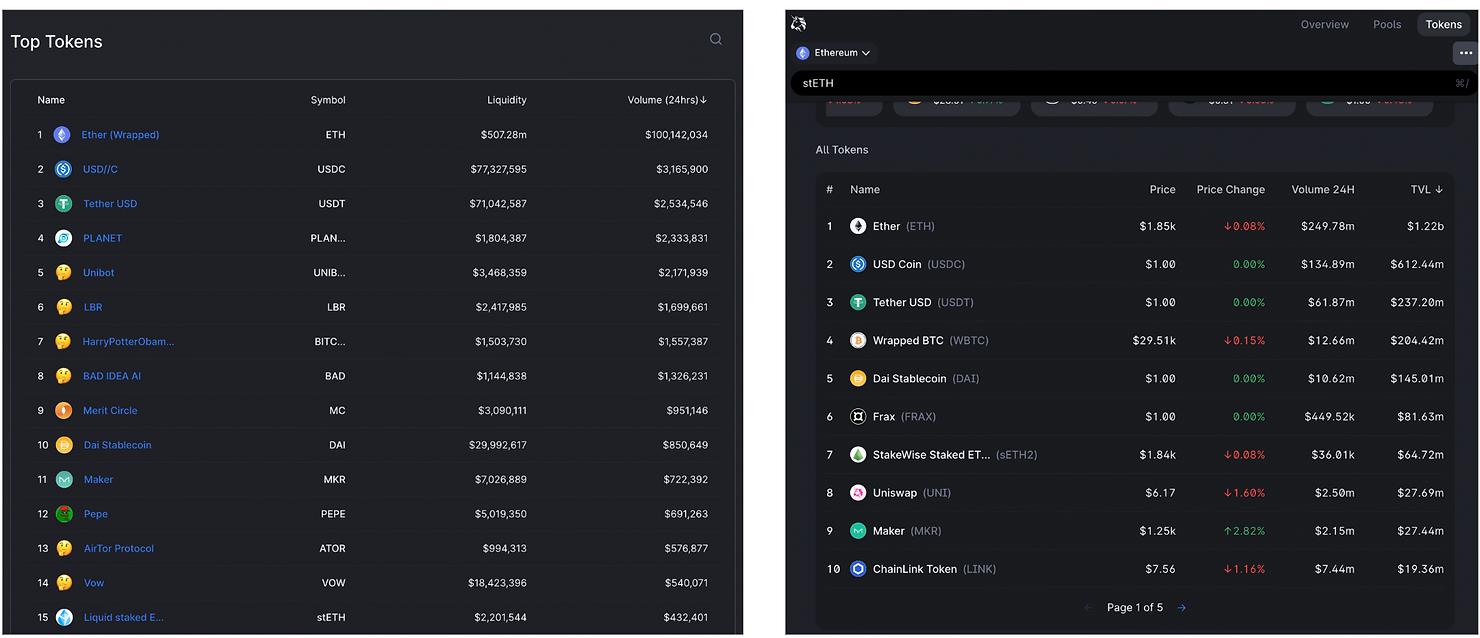
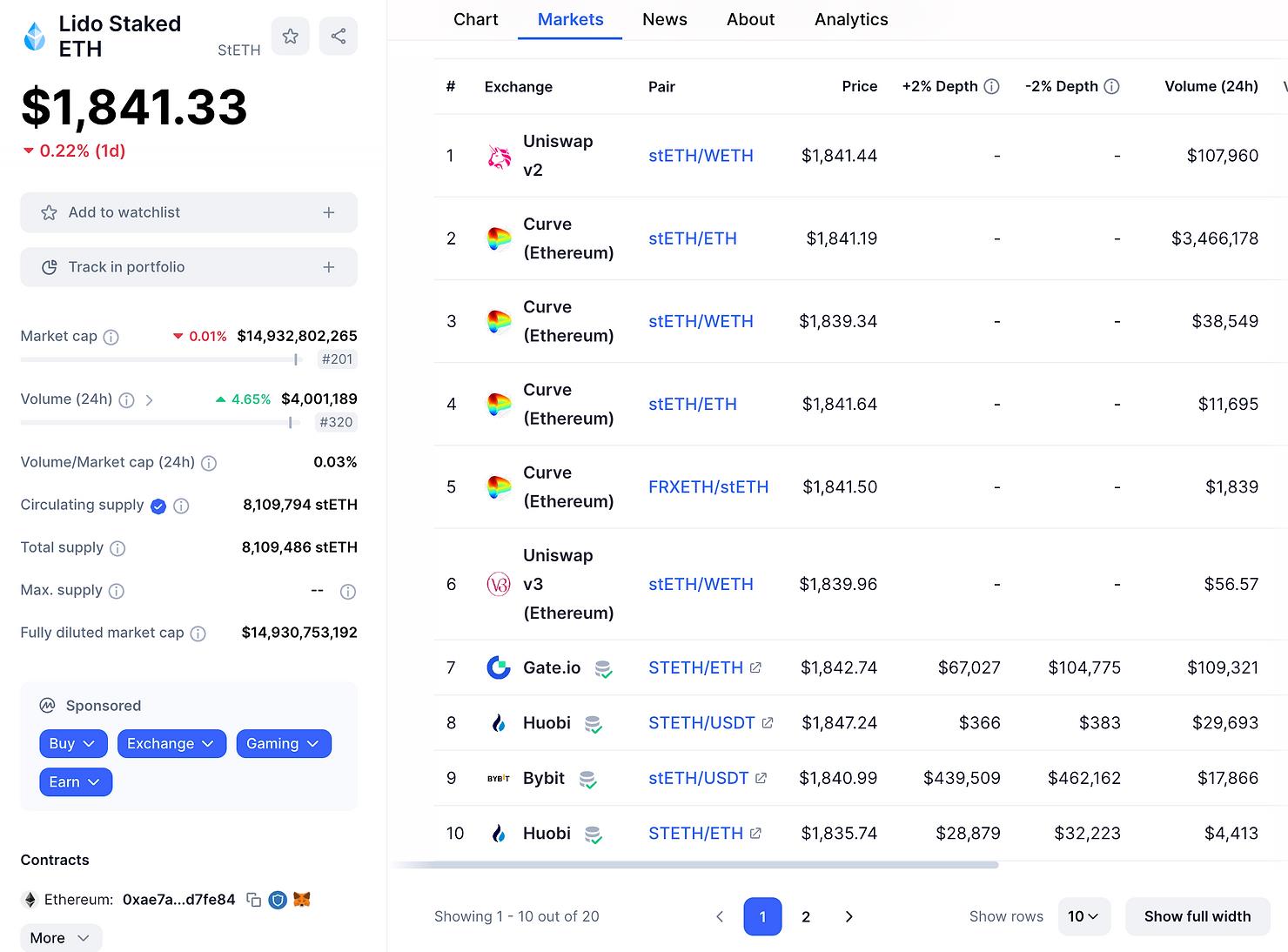
EVM Cross-Chain Currency: No Progress on L2 and Cross-Chain Bridges
Another potential use case for stETH is cross-chain transactions. As more Ethereum DeFi innovations occur on L2, it is strategically important for Lido to make stETH available at the forefront of DeFi innovation. However, if we observe cross-chain data between EVM chains, WETH and USDC are securely dominating as cross-chain currencies, while stETH is nowhere to be seen.
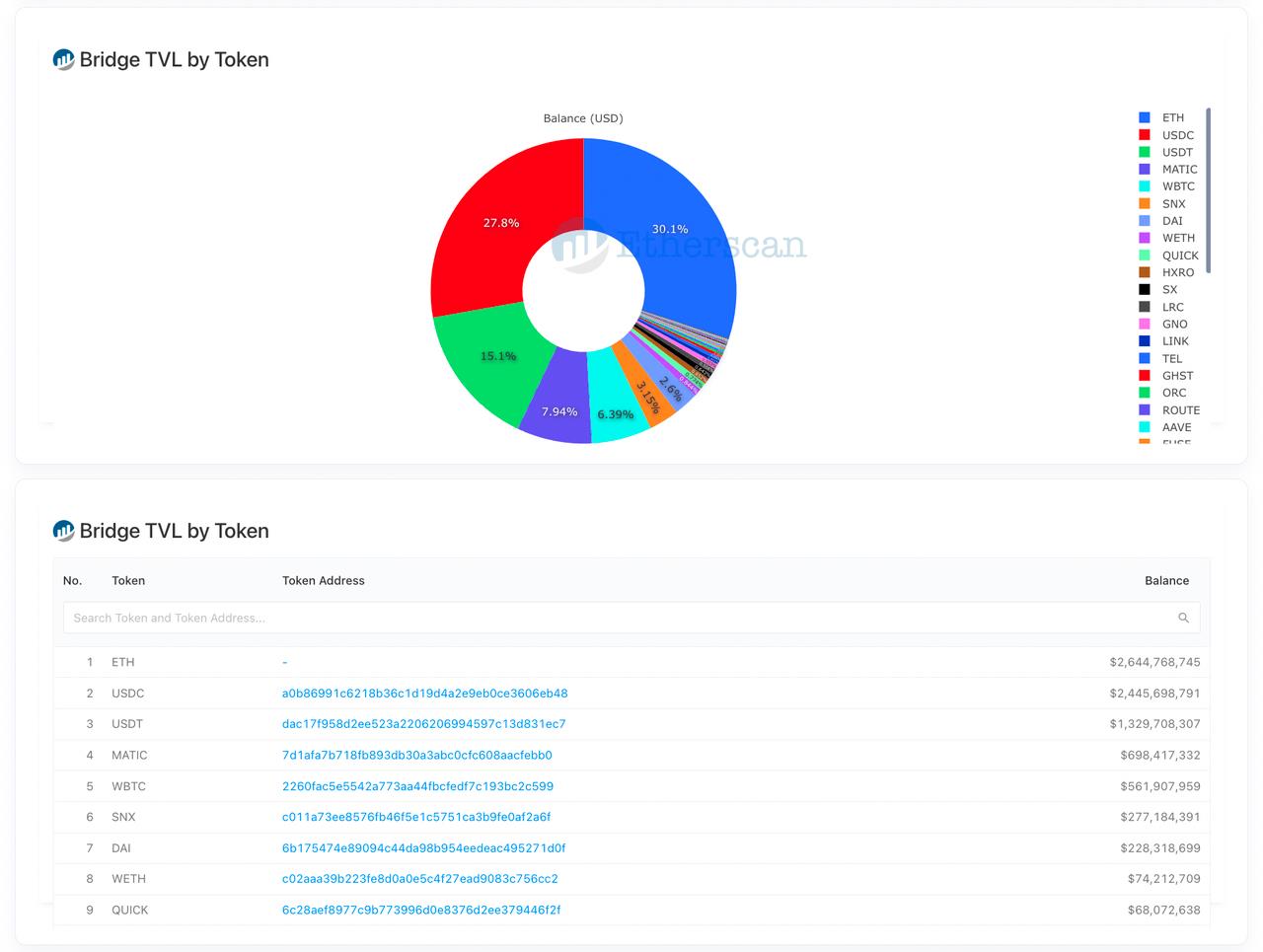
New Frontiers: Pendle and Lybra
The final piece of the puzzle is what the market calls "LSDFi" innovation. One might say, "Forget the old DeFi toys, has stETH achieved great success in new places?"
Indeed. The two top projects in this field today are Pendle and Lybra. Let's talk about them.
- Pendle is an interest rate swap market based on APY yield assets. Pendle's liquidity depends on the market value of stETH. From the perspective of real-world interest rate swaps, a derivative interest rate market is unlikely to drive the adoption of the underlying asset.
- As the yield of stETH gradually declines, Lybra's large-scale subsidy-based Ponzi economy will face increasing pressure. While we acknowledge that eUSD has a theoretical chance of breakthrough success, the opportunity to launch a new successful stablecoin in today's DeFi space is very low. (Look at Maker and Luna.) The systemic downside risk brought by large-scale redemptions/liquidations of eUSD will put stETH in a difficult position.
In summary, we have not seen encouraging signs that "LSDFi innovation" can drive the adoption of stETH in the near future.
Let's Try to Guess the Reasons: Behavioral Inertia and Familiarity with Early Maker
History: A Tough Game
Liquid staking is a tough game. Look at Solana. It has a high staking yield (initially over 8%), a high staking ratio (over 70%), and very low friction costs (Gas fees of <0.001 USD). However, Marinade Finance, Solana's main LSD provider, has less than 200 million USD in total locked value, while the total staked SOL tokens exceed 7 billion USD. This is much worse than Lido's numbers. Similar to stETH's current predicament, even at the peak of Solana's DeFi, mSOL tokens were only used as loan collateral and in similar exchange pools.
The situation is roughly the same for PoS leaders including Polygon, BNB, Polkadot, Avalanche, and Luna.
Behavior: Network Inertia
- Lending is relatively easy. stETH is a transparent synthetic asset based on the credibility of ETH. Voters on AAVE and Maker can easily approve a new asset. There is no obvious network effect required here.
- However, decentralized exchanges (DEX) and layer two scaling (L2) are difficult. To achieve the transition from WETH to stETH on Uniswap or across the entire L2, Lido needs to persuade everyone to make the switch at roughly the same time. Otherwise, inertia and liquidity fragmentation will prevent everyone.
- Thought and learning curve: Everyone who has ETH knows that ETH is the legitimate native token representing that chain. For newcomers to the on-chain world, the learning curve for understanding stETH is higher. Especially with the passing of Shanghai and the shift in attention, the adoption of LSD will further lose momentum—fewer DeFi protocols are actively discussing LSD integration today.
- Paying Gas fees and interacting with centralized exchanges (CEX) still requires the use of the native token. Just like most people only use one credit card, stETH seems optional in comparison.
Logically, overcoming network inertia requires proactive efforts in adoption incentives, partnership development, brand awareness, L2 expansion, and more. However, such initiatives have historically proven to be quite incompatible with Lido's chosen slow and steady decentralized governance model. Lido's current situation reminds us of early MakerDAO.
- Both are building public goods for Ethereum and Web3.
- Both face strong competitors with network effects (USDT and ETH).
- Neither has chosen to go beyond ETH L1.
- Both have made slow progress in DeFi integration beyond lending.
Will the decline of DAI become the tomorrow of stETH? We hope not, but we are concerned.
Conclusion and Comparison with Bullish Arguments
Finally, we would like to compare our views with some of the most important bullish arguments for LDO. We want to point out two errors in the bullish arguments and add one strategic risk.
- Staking rewards are not linearly related to the growth of the ETH staking ratio. In fact, this numerical relationship is the square root of the ETH staking ratio. For example, if the ETH staking ratio increases from the current 22% to an astonishing 88%, total rewards will only double, not quadruple. This limits the primary upside potential for Lido's revenue.
- The market share of LSD is shrinking, not growing. We believe Bryan has used the wrong comparison here. While stETH has performed better than the LSDs of Coinbase and Binance, LSD has lost market share when competing against non-liquid validator-as-a-service solutions. We have already mentioned this in the first part.
Strategic Risk: In investigating the reasons for the decline in LSD market share, we found that stETH has not successfully established a moat in areas where network effects are important (DEX, CEX, or cross-chain locking).
- The lack of network effects may hinder stETH's future growth.
- Without network effects, stETH's current use cases (SOV and lending collateral) are quite generic. Lido will continue to face competition from non-liquid staking and LSD competitors, which may lead to fee compression.
Of course, we do not dispute the reasons for a bullish outlook on Lido, which benefits from the appreciation of ETH and ETH network activity fees. For investment purposes, we believe our article provides two counterpoints:
- Before the network effects of stETH emerge, secondary LSD still has the opportunity to engage in a price war with Lido and split the LSD market.
- Before the network effects of stETH emerge, Lido's ETH exposure should be discounted, as its market share is declining in the long term (whether due to non-liquid or LSD fragmentation competition). This risk may directly manifest as a loss of market share, leading to reduced revenue, or a decrease in fee rates to match competitors.
The bear market is not over, and Lido still has time and resources to establish its network effects and set up positive feedback loops when the market recovers. We will continue to observe.












